

Contents
Contents
Safety and General Information ...................... 2
FCC Licensing Information................................10
Getting Started ..................................................11
Turning On/Off Your Radio..............................11
Installing Batteries ..........................................11
NiMH Battery Installation................................12
AA Alkaline Battery Installation......................12
Battery Meter....................................................13
Battery Life........................................................13
Battery Drop-In Charging Tray........................14
Control Buttons..................................................15
Operating............................................................16
Talk Range ........................................................16
Accessing the Backlight ..................................17
Lock ..................................................................17
Monitor ............................................................17
“Roger” Beeps/Talk Confirmation Tone ........18
Button Beeps ....................................................18
T7400 Frequency and Code Charts ..................19
Changing your Radio’s Settings ......................21
Setting the Channel ........................................21
Setting the Interference Eliminator Code ......21
Push To Talk Time Out Timer ..........................22
Setting the Call Tone........................................22
Scanning ..........................................................23
Advanced Scan ................................................23
Hands-free Use (VOX/iVOX)............................24
Setting the Sensitivity Level ..........................25
Using Accessories..............................................26
Ear-piece with Push-To-Talk Microphone ......26
Ear-piece with Boom Microphone..................26
Weather ..............................................................27
Setting the Weather Channels ........................28
Use and care ......................................................29
Troubleshooting ................................................30
Copyright Information ......................................32
Warranty ............................................................33
1

Safety and General Information
Safety and General Information
Important Information on Safe and Efficient Operation
Read This Information Before Using Your Radio.
The information provided in this document supersedes the general safety
information in user guides published prior to December 1, 2002.
Transmit and Receive Procedure
Your two-way radio contains a transmitter and a receiver. To control your
exposure and ensure compliance with the general population/uncontrolled
environment exposure limits, always adhere to the following procedure:
• Transmit no more than 50% of the time.
• To transmit (talk), press the Push to Talk (PTT) button.
• To receive calls, release the PTT button.
Transmitting 50% of the time, or less, is important because the radio generates
measurable RF energy exposure only when transmitting (in terms of measuring
standards compliance).
Exposure To Radio Frequency Energy
Your Motorola two-way radio complies with the following RF energy exposure
standards and guidelines:
• United States Federal Communications Commission, Code of Federal
Regulations; 47CFR part 2 sub-part J
2

Safety and General Information
• American National Standards Institute (ANSI) / Institute of Electrical and Electronic
Engineers (IEEE) C95. 1-1992
• Institute of Electrical and Electronic Engineers (IEEE) C95.1-1999 Edition
• International Commission on Non-Ionizing Radiation Protection (ICNIRP) 1998
• Ministry of Health (Canada) Safety Code 6. Limits of Human Exposure to
Radiofrequency Electromagnetic Fields in the Frequency Range from 3 kHz to 300
GHz, 1999
• Australian Communications Authority Radiocommunications (Electromagnetic
Radiation --- Human Exposure) Standard, 2003
• ANATEL ANNEX to Resolution No. 303 of July 2, 2002 "Regulation of limitation of
exposure to electrical, magnetic and electromagnetic fields in the radio frequency
range between 9 KHz and 300 GHz" and "Attachment to resolution # 303 from July
2, 2002"
To assure optimal radio performance and make sure human exposure to radio
frequency electromagnetic energy is within the guidelines set forth in the above
standards, always adhere to the following procedures.
Portable Radio Operation and EME Exposure
Antenna Care
Use only the supplied or an approved replacement antenna. Unauthorized
antennas,modifications, or attachments could damage the radio and may violate
FCC regulations.
DO NOT hold the antenna when the radio is “IN USE.” Holding the antenna affects
the effective range.
3

Safety and General Information
Two-way Radio Operation
When using your radio as a traditional two-way radio, hold the radio in
a vertical position with the microphone 1 to 2 inches (2.5 to 5 cm)
away from the lips.
Body-Worn Operation
To maintain compliance with FCC/Health Canada RF exposure guidelines, if you
wear a radio on your body when transmitting, always place the radio in a Motorola-
supplied or approved clip, holder, holster, case, or body harness for this product.
Use of non-Motorola-approved accessories may exceed FCC/Health Canada RF
exposure guidelines.
If you do not use one of the Motorola-supplied or approved body-worn accessories,
and are not using the radio held in the normal use position, ensure the radio and its
antenna are at least 1 inch (2.5 cm) from your body when transmitting.
Data Operation
If applicable, when using any data feature of the radio with or without an accessory
cable, position the radio and its antenna at least 1 inch (2.5 cm) from the body.
Approved Accessories
For a list of approved Motorola accessories, visit our website at www.Motorola.com.
Electromagnetic Interference/Compatibility
Note: Nearly every electronic device is susceptible to electromagnetic interference
(EMI) if inadequately shielded, designed, or otherwise configured for electro-
magnetic compatibility.
4

Safety and General Information
Facilities
To avoid electromagnetic interference and/or compatibility conflicts, turn off your
radio in any facility where posted notices instruct you to do so. Hospitals or health
care facilities may be using equipment that is sensitive to external RF energy.
Aircraft
When instructed to do so, turn off your radio when on board an aircraft. Any use
of a radio must be in accordance with applicable regulations per airline crew
instructions.
Medical Devices - Pacemakers
The Advanced Medical Technology Association recommends that a minimum
separation of 6 inches (15 cm) be maintained between a handheld wireless radio
and a pacemaker. These recommendations are consistent with the independent
research by, and recommendations of the U.S. Food and Drug Administration.
Persons with pacemakers should:
• ALWAYS keep the radio more than 6 inches (15 cm) from their pacemaker when
the radio is turned ON.
• Not carry the radio in the breast pocket.
• Use the ear opposite the pacemaker to minimize the potential for interference.
• Turn the radio OFF immediately if you have any reason to suspect that
interference is taking place.
5

Safety and General Information
Medical Devices - Hearing Aids
Some digital wireless radios may interfere with some hearing aids. In the event
of such interference, you may want to consult your hearing aid manufacturer to
discuss alternatives.
Other Medical Devices
If you use any other personal medical device, consult the manufacturer of your
device to determine if it is adequately shielded from RF energy. Your physician
may be able to assist you in obtaining this information.
Safety and General Use While Driving
Check the laws and regulations on the use of radios in the area where you drive.
Always obey them. When using your radio while driving, please:
• Give full attention to driving and to the road.
• Use hands-free operation, if available.
• Pull off the road and park before making or answering a call if driving
conditions so require.
Operational Warnings
For Vehicles with an Air Bag
Do not place a portable radio in the area over an air bag or in the air bag deploy-
ment area. Air bags inflate with great force. If a portable radio is placed in the air
bag deployment area and the air bag inflates, the radio may be propelled with
great force and cause serious injury to occupants of the vehicle.
6

Safety and General Information
Potentially Explosive Atmospheres
Turn off your radio prior to entering any area with a potentially explosive
atmosphere, unless it is a radio type especially qualified for use in such areas as
“Intrinsically Safe.”
Do not remove, install, or charge batteries in such areas. Sparks in a potentially
explosive atmosphere can cause an explosion or fire resulting in bodily injury or
even death.
Note: The areas with potentially explosive atmospheres referred to above include
fueling areas such as below decks on boats, fuel or chemical transfer or
storage facilities, areas where the air contains chemicals or particles, such
as grain, dust, or metal powders, and any other area where you would nor-
mally be advised to turn off your vehicle engine. Areas with potentially
explosive atmospheres are often but not always posted.
Blasting Caps and Areas
To avoid possible interference with blasting operations, turn off your radio when
you are near electrical blasting caps, in a blasting area, or in areas posted: “Turn
off two-way radio.” Obey all signs and instructions.
Operational Cautions
Antennas
Do not use any portable radio that has a damaged antenna. If a damaged antenna
comes into contact with your skin, a minor burn can result.
7

Safety and General Information
Batteries
All batteries can cause property damage and/or bodily injury such as burns if a
conductive material such as jewelry, keys, or beaded chains touch exposed termi-
nals. The conductive material may complete an electrical circuit (short circuit) and
become quite hot. Exercise care in handling any charged battery, particularly
when placing it inside a pocket, purse, or other container with metal objects.
Battery Charger Safety Instructions
Save these Instructions
1. Do not expose the charger to rain or snow.
2. Do not operate or disassemble the charger if it has received a sharp blow, or
has been dropped or damaged in any way.
3. Never alter the AC cord or plug provided with the unit. If the plug will not fit
the outlet, have the proper outlet installed by a qualified electrician. An
improper condition can result in a risk of electric shock.
4. To reduce the risk of damage to the cord or plug, pull the plug rather than the
cord when disconnecting the charger from the AC receptacle.
5. To reduce the risk of electric shock, unplug the charger from the outlet before
attempting any maintenance or cleaning.
6. Use of an attachment not recommended or sold by Motorola may result in a
risk of fire, electric shock, or personal injury.
8

Safety and General Information
7. Make sure the cord is located so it will not be stepped on, tripped over, or
subjected to damage or stress.
8. An extension cord should not be used unless absolutely necessary. Use of an
improper extension cord could result in a risk of fire and/or electric shock. If an
extension cord must be used, make sure that:
• The pins on the plug of the extension cord are the same number, size and
shape as those on the plug of the charger.
• The extension cord is properly wired and in good electrical condition.
• The cord size is 18 AWG for lengths up to 100 feet, and 16 AWG for lengths up
to 150 feet.
9. The supply cord of this charger cannot be replaced. If the cord is damaged, call
Motorola Product Services at 1-800-353-2729 in USA or 1-888-390-6456 TTY
(Text Telephone).
9

FCC Licensing Information
FCC Licensing Information
Your Motorola radio operates on General Mobile Radio Service (GMRS) frequen-
cies and is subject to the Rules and Regulations of the Federal Communications
Commission (FCC). The FCC requires that all operators using GMRS frequencies
obtain a radio license before operating their equipment. To obtain the FCC forms,
please request Form
605 and 159, which includes all forms and instructions. If
you wish to have the document faxed or mailed, or have questions, please use
the following contact information.
Changes or modifications not expressly approved by Motorola may void the user’s
authority granted by the FCC to operate this radio and should not be made. To
comply with FCC requirements, transmitter adjustments should be made only by
or under the supervision of a person certified as technically qualified to perform
transmitter maintenance and repairs in the private land mobile and fixed services as
certified by an organization representative of the user of those services. Replacement
of any transmitter component (crystal, semiconductor, etc.) not authorized by the
FCC equipment authorization for this radio could violate FCC rules.
Note: Use of this radio outside the country where it was intended to be distributed
is subject to government regulations and may be prohibited.
10
Faxed
Contact the Fax-On-
Demand system at:
Mailed
Call the FCC forms
hotline at:
Questions
Regarding FCC license
Contact the FCC at:
1-202-418-0177
1-800-418-FORM
1-800-418-3676
1-888-CALL-FCC
1-888-225-5322
Or: http://www.fcc.gov

Getting Started
Getting Started
Turning On/Off Your Radio
11
Turn
Knob
Display Normal Menu Mode
T7400 Display icon when the switch is power
ed ON
Turn Knob on the top of the radio clockwise to use.
Turn the Knob counterclockwise to turn the radio
OFF. The radio chirps and displays all feature icons
that your radio has available for approximately one
second.
Keypad Lock
Hi/Lo Power
Battery Meter
Quick-Talk
Weather
Channel Indicator
Scan
Talk Confirmation
Interference
Eliminator Code
Vibra-Call
VOX/Hands-free
use with or without
accessories
Installing Batteries
Some radio packages include a rechargeable Nickel-Metal Hydride (NiMH) battery,
or you may use 4 AA Alkaline batteries. If you would like to obtain the battery, the
charger or the Rechargeable Upgrade Kit, please contact place of purchase.

12
Getting Started
NiMH Battery Installation
Your radio uses one rechargeable Nickel-Metal Hydride Battery pack. These cells
provide 13 hours of radio use; based upon 5/5/90 duty cycle (5% Transmit, 5%
Receive, 90% Standby).
• To begin, slide the Ribbed Latch on the bottom of the
radio away from the back cover, or toward the contacts.
• Slide and lift the back cover off.
• Position the battery with the Motorola Logo side up, and
the charge contacts are facing the bottom of the radio.
Insert the top of the battery into the radio and push the
battery up and into the battery compartment to fit tightly
into place.
• Slide and snap the cover back into place.
AA Alkaline Batteries Installation
Your radio also uses 4 AA alkaline batteries. These cells
provide 22 hours of radio use. Based upon 5/5/90 duty
cycle.
• Push the Ribbed Latch on the bottom of the radio away
from the battery door.
• Slide and lift the battery door off.
• Place AA batteries so that the + markings match the
markings in the compartment.
• Slide and snap the battery cover into place.

Battery Meter
The battery meter located in the upper left corner of the display indicates how
much battery power you have.
NiMH/Alkaline % 100-85 85-25 25-10 Final 10
The radio will power off when the voltage drops below a pre-determined level in
order to protect the rechargeable battery. When the battery meter flashes; ,
the radio chirps after releasing and every 5 minutes.
Battery Life
The following chart lists the appropriate battery life during Two-way Use* for
Alkaline and NiMH batteries.
Battery Type Two-way Use*
AA Alkaline (High Capacity) 22 Hours
Motorola NiMH Battery-pack 13 Hours
*Two-way Use is defined as 90% standby time, 5% talk time, and 5% receive time.
Note: Use of Scan, VOX, Weather and other features may reduce Battery Life.
Getting Started
13

Getting Started
14
Battery Drop-In Charging Tray
The Drop-In Charging Tray can be placed on
any flat surface and provides drop-in charging
convenience.
• Connect Plug-in Charger and Drop-In Charging
Tray by inserting the pin into the rear of Drop-
In charging tray, insert pin as far as possible,
then stop.
• To charge the battery, place the radio into
Drop-In Charging Tray with the front of the
radio facing toward you.
Note: The battery can be charged while inside
the radio or separately. The battery’s
silver contacts must face down and the
Motorola Logo must face the front of
Charger.
The light on the Plug-in Charger will glow
continuously when radio/battery is inserted.
Note: Allow up to 10 hours for the battery to
reach full charge.
Drop-In
Charging
Tray
Plug-in
Charger
Pin

Control Buttons
15
Accessory cover/flap
Use (power) to
Turn power On/Off and
Adjust volume
Use and to
scroll through menu
settings/ Change
Channels
Use to
Turn Scan On/Off
Use to
Scroll through menus
Lock the keypad (when
held down & not in
menu)
Microphone
Indicator Light
Use to
Talk/Exit
a menu
Use to
Transmit
call tone
Speaker
Control Buttons

Operating
16
Operating Your T7400
Note: The microphone is located on the front of your radio, please refer to the
diagram on page 18.
• Press and hold .
• Talk two-to-three inches away from the microphone.
• When you’re finished talking, release .
While transmitting, the red indicator light located above the display, glows.
Talk Range
Optimal Range
Flat, open areas
• Outdoor
Medium Range
Buildings or trees
• Outdoor
Also near residential
buildings
Minimal Range
Dense foliage or mountains
• Outdoor
Also inside some buildings
• Indoor

Operating
17
Accessing the Backlight
Your radio has a Backlight that turns On automatically any time you press a front
button (except and ). The Backlight turns Off automatically five seconds
after you last pressed a front button.
Lock
• To avoid accidentally changing radio operation, press for three seconds.
Now you will see .
• The Lock Feature locks , and , and Scan functions.
When the keypad is locked you can still adjust the volume, transmit , send a
Call Tone , and monitor (Long Press).
• To unlock, press for three seconds.
Monitor
allows you to listen to all activity on a Channel to tell whether the Channel is
currently in use. can also help you determine when a radio is moving out of
range.

Operating
18
“Roger” Beeps/Talk Confirmation Tone
When you turn this feature On, your two-way radio transmits a unique tone when
you finish transmitting. It’s like saying “Roger” or “Over” and lets others know
you have finished talking. If the person you are talking to does not hear the talk
confirmation tone, you can enable it by pressing and holding as you turn On
your radio. Now, whenever you release , you let your friends know you have
finished talking by transmitting a “Roger” Beep tone. “Roger” Beeps will be
disabled as the Default Setting.
Note: To toggle the Talk Confirmation Tone feature, turn your radio Off and then
back On while pressing and holding .
Button Beeps
Every time you press a button on the front of your radio, it beeps unless you turn
Button Beeps Off. To turn Button Beeps Off, turn your radio On while you press
and hold . To turn Button Beeps back On, turn the radio Off and then back
On again while you press and hold . On is the Default setting.

Frequency and Code Charts
19
Frequency and Code Charts
The charts on these pages provide frequency and code compatibility information.
These charts are useful when using Motorola Talkabout two-way radios with other
GMRS and FRS radios.
1 0-99 462.5625 2 462.5625 FRS 1/GMRS Interstitial 1
2 0-99 462.5875 2 462.5875 FRS 2/GMRS Interstitial 2
3 0-99 462.6125 2 462.6125 FRS 3/GMRS Interstitial 3
4 0-99 462.6375 2 462.3675 FRS 4/GMRS Interstitial 4
5 0-99 462.6625 2 462.6625 FRS 5/GMRS Interstitial 5
6 0-99 462.6875 2 462.6875 FRS 6/GMRS Interstitial 6
7 0-99 462.7125 2 462.7125 FRS 7/GMRS Interstitial 7
8 0-99 467.5625 0.5 467.5625 FRS 8
9 0-99 467.5875 0.5 467.5875 FRS 9
10 0-99 467.6125 0.5 467.6125 FRS 10
11 0-99 467.6375 0.5 467.6375 FRS 11
12 0-99 467.6625 0.5 467.6625 FRS 12
13 0-99 467.6875 0.5 467.6875 FRS 13
14 0-99 467.7125 0.5 467.7125 FRS 14
15 0-99 462.5500 2 462.5500 GMRS Primary 1
16 0-99 462.5750 2 462.5750 GMRS Primary 2
17 0-99 462.6000 2 462.6000 GMRS Primary 3
18 0-99 462.6250 2 462.6250 GMRS Primary 4
T7400 Code
Channel Display
Transmit Transmit Receive
Frequency Power Frequency Description
(MHz) (Watts) (MHz)
Page is loading ...
Page is loading ...
Page is loading ...
Page is loading ...
Page is loading ...
Page is loading ...
Page is loading ...
Page is loading ...
Page is loading ...
Page is loading ...
Page is loading ...
Page is loading ...
Page is loading ...
Page is loading ...
Page is loading ...
Page is loading ...
Page is loading ...
Page is loading ...
Page is loading ...
Page is loading ...
Page is loading ...
-
 1
1
-
 2
2
-
 3
3
-
 4
4
-
 5
5
-
 6
6
-
 7
7
-
 8
8
-
 9
9
-
 10
10
-
 11
11
-
 12
12
-
 13
13
-
 14
14
-
 15
15
-
 16
16
-
 17
17
-
 18
18
-
 19
19
-
 20
20
-
 21
21
-
 22
22
-
 23
23
-
 24
24
-
 25
25
-
 26
26
-
 27
27
-
 28
28
-
 29
29
-
 30
30
-
 31
31
-
 32
32
-
 33
33
-
 34
34
-
 35
35
-
 36
36
-
 37
37
-
 38
38
-
 39
39
-
 40
40
-
 41
41
Motorola T7450R - 22 Channel Camoflauge GMRS User manual
- Type
- User manual
- This manual is also suitable for
Ask a question and I''ll find the answer in the document
Finding information in a document is now easier with AI
Related papers
-
Motorola TALKABOUT KEM-ML36100 User manual
-
Motorola Talkabout T9580RSAME User manual
-
Motorola Talkabout T9580RSAME User manual
-
Motorola MG160 Series User manual
-
Motorola T4500 User manual
-
Motorola T7100 Series User manual
-
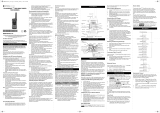 Motorola Solutions 843631130544 User manual
Motorola Solutions 843631130544 User manual
-
Motorola T5509R User manual
-
Motorola T5509R User manual
-
Motorola MH230R - Range FRS/GMRS Radio User manual
Other documents
-
Conceptronic C08-029 Datasheet
-
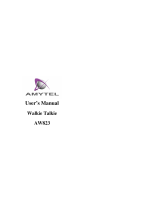 Amytel AW823 User manual
Amytel AW823 User manual
-
Quanzhou Wouxun Electronics WOUXUN21 User guide
-
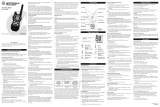 Giant Electronics K7GMRCEJ User manual
Giant Electronics K7GMRCEJ User manual
-
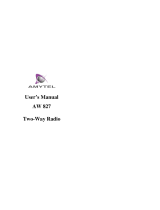 Amytel AW 827 User manual
Amytel AW 827 User manual
-
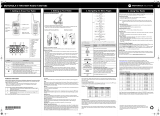 Motorola Solutions T380 Two-Way Radio User guide
Motorola Solutions T380 Two-Way Radio User guide
-
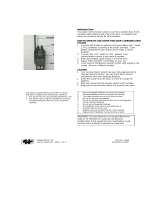 200 Toy (HK) O4Y10668 User manual
200 Toy (HK) O4Y10668 User manual
-
Olympia R300 Series Owner's manual
-
Olympia R300 Series Owner's manual
-
Radio Shack Tone/Vibration Pager User manual














































